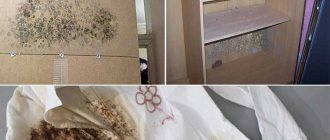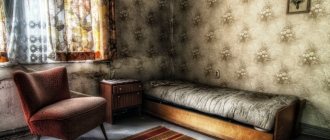Mold is a microscopic fungus that grows on damp or rotting things. The microorganism causes an unpleasant, stale smell in the apartment. To eliminate the enemy, it is necessary to remove the source that provoked the appearance. Simple, affordable products that are stored in the kitchen or in the medicine cabinet will help you get rid of the smell of mold in your closet.
Where to look for the source of mold?
Even if you smell mold in your closet, it doesn't mean it has spread there. The fungus lives in warm and humid places, which means it can be behind a closet wall, in peeling wallpaper, or right in clothes if they are not dried well.
The characteristic colors of mold are gray, green, blue, black. If you find it, immediately take measures to remove it, because the fungus spreads very quickly, affecting any surfaces along the way.
At first you will smell it and only after a while you will see the mold.
How can you tell if it's really the smell of mold if you can't see it yet? Its stench is bitter and damp.
Mold moves into closets with clothes from the following media:
- air ducts;
- rotten walls;
- the back of the furniture;
- rarely used books;
- carpet;
- mattresses;
- ceiling tiles.
How to make your closet smell more pleasant and gentle
Destroying the fungus helps eliminate the musty smell. At the same time, things can be given a more pleasant aroma. This is quite simple to do; just lay out on the shelves any substances that have a strong aroma. They may be:
- cosmetic soap;
- empty perfume bottles;
- herbal and flower preparations;
- special air fresheners.
Any of these solutions will give things a lasting, pleasant aroma. In addition, an increased concentration of essential oils in the air has a negative effect on the structure of the fungus. It stops actively growing and releasing spores. The choice of a specific product is based solely on the person’s preferences and his desire to diversify the atmosphere of the closet. At the same time, cosmetic soap has a persistent delicate aroma that remains on the fabric for a long time. Perfume bottles impart a delicate, slightly sweetish aroma to things. Herbal and flower infusions have unsurpassed characteristics and not only improve the smell in the closet, but also prevent the appearance of moths. Special fresheners stay on things for a long time, but have a somewhat artificial smell.
A wardrobe is an essential attribute of any apartment. Outerwear, bedding and personal items are just a small part of what can be stored in it. At the same time, the situation when a damp smell forms in the closet is familiar to many. The main reason for this phenomenon is a fungus. It is he who secretes a specific enzyme that people perceive as mustiness. Its neutralization ensures the complete elimination of unpleasant odors, and it can be done using improvised means, which can always be found in any apartment.
Cabinet treatment to remove fungus
While the items are drying and washing, sanitize the closet. Furniture is moved away from the walls and, if sources of infection are already visible, they are removed with home remedies - baking soda, vinegar, alcohol (ammonia), citric acid, bleach and chemicals.
As additional measures after treatment, an aromatic sachet is used, which is placed directly in the closet and between layers of clothing after treatment.
How to clean cabinets with baking soda?
All products have their benefits, but the safest of them all is baking soda. It is even suitable for processing cabinets with children's linen:
- Dissolve soda in water. Use 3 tablespoons per liter of water.
- Dampen a sponge or rag in this solution.
- Wipe down the cabinet walls and shelves. Pay attention to the back wall of the cabinet.
- After treating with the solution, wash the cabinet with clean water.
- Keep the cabinet open for 4 days until it is completely dry.
How to clean cabinets with bleach?
Bleach can also deal with odors and fungal growths. But here you need to act differently:
- After emptying the closet of clothes, open the doors and place the dehumidifier inside. If not available, use a fan. If possible, move the cabinet outside into the open air in clear weather.
- Mix equal parts bleach and water and dampen all surfaces of the cabinet. It is very important not to add additional detergents to the composition, this can cause an unpredictable reaction and harm your health.
- After treatment, the inner walls of the cabinet are washed with ordinary cold water.
- Keep the cabinet open for at least three days, further drying it with a fan or dehumidifier.
Make sure there is no trace of odors left in the closet. Each corner of the furniture should be dried and only after that put the clothes back.
Other ways to remove mold smell
The following tools will also be useful:
- Vinegar
.
To apply to surfaces, dilute equal parts of water and vinegar, wipe the surfaces and leave to dry. Hydrogen peroxide
works on the same principle. - Bleaching .
A good product, but not suitable for everyone. Its use can result in white spots on the furniture, so if the cabinet is expensive, try baking soda and vinegar first, and in extreme cases, use bleach. - Chemicals.
Use last because they are not always safe for use in adults or children. If you use it, follow the instructions carefully.
Read our other articles:
- How to get rid of smell in the refrigerator: tips from personal experience.
- How to get rid of unpleasant foot odor:
- How to get rid of an unpleasant smell in an apartment? Methods that will help are described here.
Prevention
It is easier to prevent the appearance of mold odor than to get rid of it later. For this:
- Store clean clothes separately from those you wear.
- Place only dry clothes in the closet.
- Do not dry clothes indoors (at least not in the kitchen).
- Do not place the wardrobe close to the wall, especially if the wall is problematic (has traces of mold).
- Ventilate the closet regularly, emptying it of everything that is inside.
(Visited 10,360 times, 10,360 visits today)
Share
What to do if mold is already on clothes?
If the fungus has spread to the walls of the closet, then it is probably already in things. Clothes are taken out to the balcony or outside in the sun on a clear day and aired, first turning them inside out - especially capricious items, so that the fabric does not fade in direct rays.
Simple airing will get rid of the smell and the fungus itself, so after drying, all clothes need to be washed. You don’t need to invent anything - just regular washing with powder. The use of additional odor removal products is encouraged. Linen is dried and always ironed.
But what should you do if, in addition to the smell, stains have formed on your clothes? Throw out old things and try to save new ones, but only if the infection is partial. They work with each individual fabric individually:
- Cotton items
are sprinkled with crushed chalk powder, paper sheets are placed on top and ironed without steam. - Silk and woolen items
are sprinkled with dry clay, then a layer of turpentine is applied and covered with paper. Iron the charged areas with a hot iron. Please note that the processing method is only suitable for dark fabrics; light fabrics are not processed this way. - Light and white items
can be cleaned by soaking them in hydrogen peroxide.
If the spots are small, try mixing lemon juice, salt and onion juice. Apply the mixture to the stains and wait 15 minutes.
If the proposed processing methods do not suit you, use regular table salt:
- Add 2 tbsp to a liter of water. spoons of salt;
- Pour in a teaspoon of ammonia;
- Place the liquid on the fire until it boils;
- When the solution boils, remove from heat and wait for it to cool completely;
- The area of fabric with mold is moistened with the solution and left for an hour. Then carry out normal washing.
Regardless of the processing method, the laundry is dried in direct sunlight, washed and ironed without the use of steam. If there are still pockets of mold in the closet, you will never get rid of the smell. An integrated approach is important.
Carbon and soda filters
Due to its porous structure, carbon is considered one of the best adsorption agents. It is able to absorb most contaminants and also neutralize odors. Activated carbon is poured into a bag made of breathable fabric and left in a closet for several days.
When combined with baking soda, activated charcoal can combat the smell of mothballs, which some people still use to fight moths.
How to treat kitchen cabinets?
Kitchen furniture, including household appliances, are also susceptible to mold odors. The first thing you need to do is wash the surface using a solution of water and laundry soap or bleach. Treat the doors, shelves, and walls with the composition.
As an alternative, you can use a vinegar solution, which is prepared using slightly warm water with the addition of seven tablespoons of vinegar. Put on gloves, treat work surfaces with vinegar solution and open the window wide. It is better not to enter the kitchen for several hours, and then you need to wash the surfaces with clean water.
After such procedures, do one of the most attractive things for you:
- Place saucers with coffee beans on the shelves. You can also use ground, but it must be natural. Soluble “sand” will not capture odors as well.
- Place 5 slices of fresh lemon in saucers and place on each shelf. Use the skins and zest too. Lemon absorbs odors perfectly.
- A small bowl of baking soda will absorb unpleasant odors in 3 days. Place containers in the farthest corners.
Sometimes housewives use aromatic products, for example, essential oils, but in the kitchen you need to be careful with this and use it only for walls and floors. In the same place where the products will be placed, the option with essential oils is not suitable.
Salt and tea for high humidity
If the closet is used to store outdoor clothes or shoes, high humidity and, as a result, a damp smell appear quite quickly. To prevent the formation of mold and remove unpleasant odors, place containers with table salt in the corners of the drawers.
Along with salt, ordinary tea bags help cope with excess moisture. You will have to change them once a week, and you can forget about the smell of dampness for a long time.
How to prevent mold?
If you are afraid of mold, take steps to prevent it, which is much easier than having to get rid of it later.
- Buy silica gel balls from a hardware store. They prevent dampness from forming in unventilated places such as closets.
- Ventilate the inside of the furniture and do this once every 4 weeks. Open your closet wide, open the windows and take your clothes out into the sun.
- Carry out wet cleaning regularly.
- Get rid of old things, especially if they already have a characteristic smell.
- In summer, place furs, blankets and pillows in the sun.
- After washing, all items should be ironed.
- During deep cleaning, check the back of the cabinet. This is the first place where mold can form.
If the smell of mold has moved from the closet to the room, then use the tips in this article.
What can cause an unpleasant odor?
Foreign odor may appear for various reasons. The main one is mold. In conditions of high humidity and stable temperature, mold microorganisms actively multiply, and in a closed chest of drawers, their metabolic products quickly begin to give off a characteristic odor that is difficult to get rid of.
Causes of mold:
- Placing insufficiently dried clothes in the closet;
- Formation of excess humidity inside due to the presence of dampness in the room.
Wood absorbs moisture (and odors) well, creating comfortable conditions for mold. Getting rid of it is the first priority.
Another unpleasant smell found in old chests of drawers is mothballs. Previously, balls containing this substance were used against moths, but their persistent odor can persist for decades.
The ability of wood to absorb causes the presence of odor in almost any antique furniture, unless special measures have been taken to get rid of it. An old musty smell is formed by a complex mixture of aromas that have ever been in a given piece of furniture.
Finally, the presence of smokers or active athletes in the house are two more reasons for the appearance of an unpleasant odor.
Where exactly can it appear?
In short, the main places of appearance are:
- Corners in cabinets (upper or lower).
- The back walls of cabinets from the back (more often) or from the inside (less often) (especially if the furniture is located close to the wall bordering the street).
- The space under the closet, if this is a room on the ground floor, and there is an unheated and/or damp basement below.
- The surface of the wall behind the cabinet, if the wall borders the street.
By the way, in addition to cabinets, fungus can also appear in the chest of drawers and under the mattress (if you store things under it).
Even if there is a persistent musty smell from the closet, you cannot be sure that the mold appeared there. It may be that the fungus has settled on the wall behind the closet, and it is from there that the specific stench is felt.
Plaque can also occur in the closet. Most often it is localized in corners or on wooden surfaces that are not sufficiently protected (not treated with varnish at all, or poorly treated, or the varnish coating has crumbled over time). It often extends to clothes and shoes that are in the closet.
Moreover, mold deposits most often develop on things that have not been used for a long time, that have been lying in one place for months. Also at risk are things that are packed too tightly (folded).
Spores may be localized primarily in damp areas of the cabinet. For example, if there is a source of leakage above the cabinet after rains. Therefore, furniture located in utility rooms, attics, and on the top floors of old houses (or houses with a bad roof) suffers most from fungus.
Mold behind the cabinet
Be sure to inspect the corners of the cabinet surface, as well as the area under it - these are also favorite places for mold microorganisms. Inspect the furniture standing near the closet (or, especially, close to it) - disputes could also spread to it.
Be sure to make sure that the clothes you put in the closet are dry: mold appears much faster and more often on damp things.
Reasons for appearance
Main reasons for development:
- Humidity (dampness) in the room where the cabinet is located.
- Storing wet clothes (especially too tight storage).
- The spread of mold with clothes is possible through the washing machine (if the fungus appears in it, then during the washing process the spores can get on things and then be transferred to the closet).
- The location of the cabinet is close to the wall, which can be wet (for example, when it rains).
- Lack of normal air circulation in the furniture (if it is tightly closed and has no cracks, and rarely opens).
- The habit of storing unwashed items.
- Furniture that is too old and has rotten areas.
- Placement of furniture in the corner of the room.
Why is this dangerous?
You need to start with the most banal thing - infected furniture smells unpleasantly of dampness (something like wet clay).
It doesn’t matter what kind of mold has settled inside - white or black, or other colors - it will still stink. In addition, wooden cabinets will rot and fall apart over time, or simply become deformed (although this requires not noticing the fungus on the furniture for a very, very long time).
Damage is also caused to the clothing inside:
- From contaminated clothing, spores can get into the washing machine, from there onto other things, and through them onto any object in the apartment (on the carpet, on the bed, on any other surfaces).
- Things smell bad. Moreover, this causes not only discomfort: if there are a lot of spores in the tissue, then when they are inhaled, a person will begin to sneeze. In particularly difficult cases (if a person has allergies, or is simply in poor health), an allergic reaction is possible.
The accumulation of mold spores can seriously affect the health of residents. Even healthy people are at risk, since mold, being a fairly strong allergen, can trigger the development of bronchial asthma.
If people with bronchial asthma already live in the apartment, then the course of the disease may worsen, repeated attacks of suffocation, and systemic allergic reactions. This includes possible angioedema and bronchospasm, which can be life-threatening.
“Symptoms” of appearance: how to understand that mold has appeared in the closet?
It is hardly worth thinking seriously about how to find out that mold has appeared in an apartment (or specifically in a closet): in most cases, you will not miss it. You can only miss the initial stage, when the fungus has not yet grown and is not noticeable to the naked eye (but there are already spores).
Mold behind the bedside table
Main signs of appearance:
- persistent nasty smell of dampness in the apartment, mustiness (initially weakly felt, intensifies as the amount of fungus increases);
- the development of local or systemic allergic diseases in people who have not previously suffered from them (sneezing, bronchospasm attacks, lacrimation, nasal congestion that occurs when opening a closet or putting on clothes from it);
- the appearance of a mold stain directly in the cabinet itself, or in the area around it (under or above it, on the wall).
Ways to fight
Before starting work to eliminate the smell, you should understand the reason for its appearance, after which it will become easier to choose measures. In any case, the first step should be to thoroughly wash and dry the cabinet.
Complete cleaning and revision
First you need to audit and clean out your closet:
- All items should be removed from the wardrobe, washed and sorted. If necessary, take to the dry cleaner what you cannot wash yourself.
- It is necessary to move the wardrobe away from the wall. Rinse the outside, remove any accumulated dust, check for mold on the walls.
- Remove shoe boxes from the closet.
- Hang things out in the fresh air to thoroughly dry and remove detergent odors.
- If things have not been used for more than a year, transfer them to another place, pack them in vacuum bags, throw away the old ones.
- Rinse the wardrobe from dust and remove debris. Treat all surfaces with disinfectant cleaning agents.
- Dry and ventilate the cabinet well, leaving all the doors open for a couple of days.
- A very old cabinet that cannot be ventilated can be painted inside with varnish or paint.
You can return things to their place if the cabinet has completely lost its unpleasant smell.
How to remove mustiness
Things that are rarely used or stored for a long time without removal and airing acquire a musty smell. Let's look at simple ways to eliminate mustiness.
Ventilation
An influx of fresh air is the best and most affordable way to help freshen things in your wardrobe. Before leaving home, you should periodically open all doors and pull out drawers. While no one is home, things can “breathe.”
Breezer
A small household appliance creates fresh ventilation and refreshes the air well. The breather provides multi-stage cleaning and gets rid of the musty smell of things.
Cleaner-disinfectant
The industry produces special air purifiers that kill germs and bacteria. Disinfectants suppress the activity of microorganisms, a common cause of unpleasant odors.
White and apple cider vinegar
Different types of vinegar help get rid of the unpleasant aroma of things and the wardrobe itself. Apple and table vinegar are used in several ways:
- pour into a bowl and place in a closed wardrobe;
- add to water and wash the walls of the wardrobe;
- when washing, pour into water during rinsing or along with powder.
The smell of vinegar disappears quickly, leaving clothes and linen with a fresh aroma.
Charcoal
Filters and odor absorbers are made from different types of coal. Charcoal is poured with water and placed in a bowl in the wardrobe. Activated carbon tablets are tied into napkins made of loose fabric and laid out in cabinets.
Air vent
For built-in cabinets, it is convenient to make air vents that will pump in fresh air and remove stale air. They are provided during the furniture assembly process and built into the ceiling of the wardrobe.
Dampness and mold
High humidity in cabinets causes damp and moldy odors. This is usually typical for humid apartments, where the air constantly contains excess moisture.
Table salt absorbs water well. It is placed in closets in small containers - in corners, in drawers. If necessary, replace with a new portion. With excess water, the unpleasant aroma goes away.
Tea bags
Tea bags will help remove the damp smell. They are laid out in the closet and changed once a week.
Place baking soda in open saucers in the corners of the wardrobe and periodically replace it with fresh one.
Silica gel
A convenient means for extracting moisture from the air is silica gel. It is laid out in bags throughout the wardrobe.
Steam generator
Modern steam generators are assistants in disinfecting things. They eliminate odors and kill germs. The inside of the cabinet can also be treated with a steam generator, then dried thoroughly.
Antifungal agent
The growth of fungal colonies often occurs when there is excess humidity, especially if shoes, poorly washed socks and tights are stored in closets. To remove odors, antifungal agents are used, which are used to treat the walls of furniture and add them during washing.
Eliminating the cause
Dampness in closets usually appears due to high humidity in the apartment. Wardrobes adjacent to wet areas - bathrooms, kitchens, toilets - are especially often affected.
To eliminate the cause, a whole range of work will be required:
- maximum removal of the cabinet from the wall, identification of mold and treatment with antifungal agents;
- establishing ventilation in rooms with high humidity - cleaning outlets, installing forced ventilation;
- use of automatic dehumidifiers.
Cabinets need to be ventilated regularly, all contents taken out, and doors left open more often. Mold does not like air or sunlight. Ventilation holes can be made in the back wall - in the lower and upper parts.
Milk bath
Milk is an excellent odor absorber. To remove extraneous aromas, you need to boil the milk in a saucepan with a wide bottom and put it in a cupboard until it cools completely (30-40 minutes). This old folk remedy has been used by many generations of housewives.
Sachet for linen
Scented laundry bags (sachets) with herbs help eliminate damp odors. But first you need to wash and dry your wardrobe.
Tip: special odor absorbers will help remove unpleasant odors from your wardrobe.
Smell of tobacco
The following methods can remove tobacco spirit from the cabinet:
- airing and washing things, washing the wardrobe;
- hanging a damp towel inside;
- laying out roasted coffee beans.
Placing burnt laurel leaves in the wardrobe quickly eliminates the smell of tobacco.
If animals visited
Cats are able to sneak into any place and leave their marks.
Special and home remedies will help you remove stench from cat urine:
- pet store odor absorber;
- citric acid solution (0.5 tablespoon per liter);
- hydrogen peroxide.
Treating the walls with water and vinegar or a cloth soaked in hydrogen peroxide will help eliminate the smell of mice.
Naphthalene
Mothballs are often used to protect the contents of the wardrobe from moths. The following will help remove the unpleasant mothball spirit:
- dry mustard scattered on the shelves;
- ground cloves;
- coal, soda.
You can place an industrial odor absorber in the wardrobe.
Dresser with shoes
Shoes are sent for storage clean, well dried and cleaned. Help rid shoes and storage chests of odors:
- treatment with alcohol, vinegar solution, hydrogen peroxide;
- special air fresheners with protection against fungi;
- coffee beans, bags of citrus fruits, sachets - placed inside the shoes.
The shoe chest of drawers should be regularly ventilated, the walls should be washed with vinegar and furniture detergents.
Medicines
Medicines have a pungent odor, especially alcohol solutions and tinctures. They should be kept carefully closed to prevent the medicine from spoiling. Help remove odor:
- audit and removal of expired products and medications with broken caps;
- washing the cabinet with a solution of vinegar and citric acid.
You can place plates with roasted coffee beans and a swab with essential oil on the shelves.
Fresh purchase
When buying a new wardrobe, you shouldn’t immediately fill it with clothes - they will absorb all the smells of the new materials. Clothes will smell of varnishes, paints and other substances used in production for a long time.
You need to open all the doors and leave the furniture in a well-ventilated area. Then rinse the walls on all sides with water and vinegar (a tablespoon per liter of water), close the doors. You can place tea bags and charcoal inside.
Things are loaded when the aroma of new furniture completely leaves the apartment.
How to get rid of fungus?
If mold is discovered, it is necessary to take immediate measures to get rid of it, otherwise it will spread very quickly to all things, and then it will simply be impossible to do anything to restore the damaged things. If the fungus appears on the walls of the closet, then it has definitely settled in the clothes.
In this case, you must act as follows:
- All clothes and bedding must be placed on the balcony, hung in the sun, turned inside out.
- Then treat the cabinet with a special anti-mold compound,
- As soon as the items have dried a little in the sun, wash them with a special detergent
- Then dry them, iron them and put them back on the shelves.
Reasons for appearance
All apartments and houses have an individual smell, which is formed by the peculiarities of life of the inhabitants. Clothes and linens locked in closets are constantly crowded into a limited space. To know how to effectively remove unpleasant odor from things, you need to know why it appears.
Stuffiness
Stuffiness, lack of freshness and oxygen flow lead to stagnation of air, accumulation and retention of special odors inside the wardrobe that come from rooms and from clothes. Foreign matter is locked in the closet and saturates clothes and linens.
Humidity
At high humidity, fungi and other microorganisms multiply quickly. They give things a musty and damp smell. Poorly dried items placed in a closet dry slowly and contaminate other clothes with the smell of dampness.
Small particles of dust, dirt and debris are present on worn clothes placed in the closet, and also penetrate from the premises. They can introduce various unpleasant odors onto clean laundry.
Bacteria
Ubiquitous bacteria are found everywhere - in dust, undried laundry, washed and worn clothes. Their waste products have various unpleasant odors, which intensify during long-term storage.
Tobacco smoke
Tobacco smoke permeates clothes and spreads throughout the closet. The old smell of tobacco can become dominant in the apartment, and it is not easy to get rid of it if someone in the apartment constantly smokes.
Old clothes
Old things stored in closets for a long time collect all the aromas in the apartment. Large items smell especially strongly - old coats with synthetic and natural fur, blankets, fur coats. When stored for a long time, the smell of old age and mustiness appears; even washed items acquire the specific aroma of attics and basements with old stuff.
Ironing
It is very difficult to steam things while ironing until all the water comes out. If piles of laundry are immediately put into storage, the folded items will take a long time to dry. Washed laundry will smell musty and damp.











